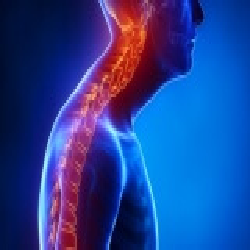
People sit with their head positioned in various ways; this is determined by a combination of factors including musculoskeletal structure, age-related body changes, motor performance, occupation, and cultural customs. A forward head posture with rounded shoulders (FHPRS) due to a poor sitting posture is defined as a forward head position with thoracic kyphosis and more anterior shoulder positions; such a posture is associated with altered scapular positions, kinematics, and muscle activities. These alterations consequently increase muscle tension and stress at the neck and shoulder, resulting in pain, numbness, loss of function, and various neuromuscular symptoms, which most often affect the upper body.
While sitting forward head inclination involves lower cervical flexion and upper cervical extension and rounded shoulders, which reduce the average lengths of muscle fibres, contributing to extensor torque around the upper cervical joint. In addition, this abnormal state causes musculoskeletal abnormalities such as decreased scapular upward rotation as well as greater internal rotation and anterior tilting, which may lead to impingment syndrome.
Why is this relevant?
Forward head, rounded shoulder posture (FHRSP) is a common postural fault observed in rehabilitation settings. Prior research has indicated altered muscle activation of individuals with FHRSP in comparison to normal healthy controls when performing an overhead lifting task. The current study adds to this developing body of research by investigating performance of a similar overhead task under different sagittal plane alignments of the head in individuals with FHRSP. The aim of the study was to determine if muscle activation of the upper and lower trapezius, sternocleidomastoid, and serratus anterior would significantly change with a sagittal plane postural correction without any concomitant musculoskeletal intervention.
Methods:
- 40 subjects who had FHPRS.
- Activities of different shoulder muscles in three head positions
- Natural head position (NDP) which is forward head posture with rounded shoulder.
- Ideal head position (IDP) subjects were instructed to sit with the head in a “balanced position” considered by the subjects to be ideal without any manual or verbal feedback regarding the position adopted.
- Corrected head position (CHP) the subjects were placed in a neutral posture by experienced therapists using manual and verbal feedback to reflect clinical practice.
They have measured muscle activity (EMG with surface electrod) during an overhead reaching task in 3 sessions comprising 3 repetitions with a 30-second rest periods between repetitions.
The muscle activities of upper trapezius, lower trapezius, serratus anterior and sterno cleido mastoid were measured.
Results:
Regarding muscle activities, the UT and SA muscle activities differed significantly among groups.However, there were no differences in SCM or LT muscle activity among groups.
The post hoc test showed there were significant differences between the NHP and IHP, and NHP and CHP groups with respect to both UT and SA muscle activity; however, there were no significant differences between the IHP and CHP groups.
Conclusion:
we can conclude that there is no much difference in muscle activitie shoulder ideal postrure and controlled head position. Activites of SA and UT was significantly better with IHP and CHP compare to NHP. Which is important for optimal scapular movement and in turn optimal shoulder functioning.
Clinical implementation :For shoulder rehabilitation,head postion play major role .control the lower cervical flexion and activate the SA & LT.
Reference:
- Changes in upper-extremity muscle activities due to head position in subjects with a forward head posture and rounded shoulders Jung Won Kwon, PhD, PT1), Sung Min Son, PhD, PT2), Na Kyung Lee, PhD, PT1)


